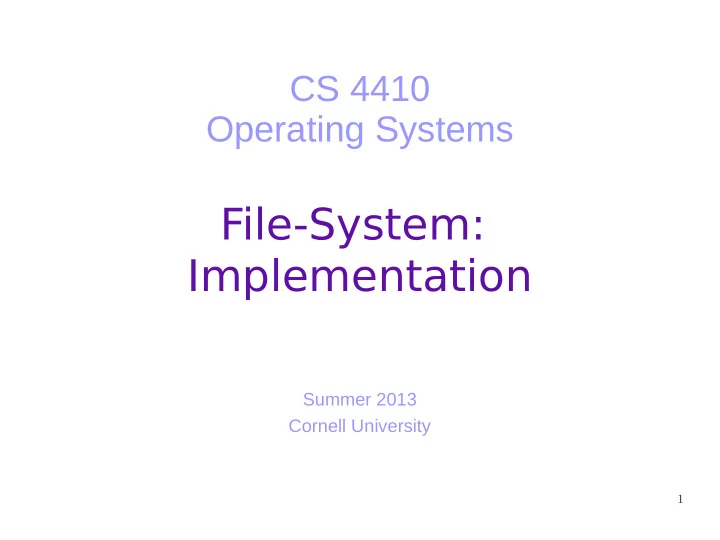

CS 4410 Operating Systems File-System: Implementation Summer 2013 Cornell University 1
Today ● How is the file system implemented? ● Layered file system ● Directory implementation ● Allocation methods ● Free-space management 2
File Systems ● Two design problems: ● User's interface: – Definition of a file, attributes, operations allowed, directory for organization. ● Hardware interface: – Create algorithms and data structures. – Map logical file system onto the physical storage device. ● To simplify the design of a file system, several intermediate layers are implemented. 3
Layered file system Application programs ● File permitions Logical file system ● File dates File owner Directory structure ● File size File structure via file-control blocks ( FCB ) File data blocks ● FCB Metadata; not actual data ● File-organization module ● Translate logical block addresses to physical block addresses. ● Free-space manager ● Basic file system ● Issue generic commands to device driver. ● Read and write physical blocks. ● Manage memory buffers and caches. ● I/O control ● Device drivers with interrupt handlers. ● Transfer information between the main memory and the disk. ● Write to device controller's memory the location and the action of interest. ● 4
Example: open() The open() call passes a file name to the logical file system . ● The system-wide open-file table is searched. ● If the file name is found , the new per-process open-file table entry points to the ● corresponding entry of The system-wide open-file table. Else , the directory is searched for the file name. ● Once it is found, its FCB is copied into a new entry of the system-wide open-file ● table . And, a new entry is created at the per-process open-file table, pointing to the entry ● above. In both cases, the open() call returns the pointer of the new entry in the per-process ● open-file table. 5
Directory Implementation ● The main function of the directory system is to map the ASCII name of the file onto the information needed to locate the data. ● Every time we open a file, which has not been opened yet in the system, we find its directory and search its entry . ● How are we going to implement the directory structure? 6
Directory Implementation ● Linear List ● List of file names with pointers to the data blocks. ● Simple ● Time consuming execution: – Create, search, delete. ● Hash Table ● Takes a value computed from the file name. ● Returns a pointer to the linear list. ● Simple insertion, deletion. ● Attention with the collisions. 7
Allocation Methods ● Remember: Data is saved as blocks in the hard disk. ● How do we allocate space (blocks) to the files so that: ● Disk space is utilized effectively. ● Files are accessed quickly. 8
Contiguous Allocation 9
Contiguous Allocation Each file occupy a set of contiguous blocks on the disk. ● Minimal disk seeks and seek time . ● The directory entry for each file indicates the address of the starting ● block and the number of blocks used . It supports both sequential and direct access. ● Difficulty in finding free space. ● Dynamic storage-allocation problem ● External fragmentation ● – Solution: Compaction Determine space needed for a file. ● 10
Linked Allocation 11
Linked Allocation ● A file is a linked list of disk blocks . ● The directory entry contains a pointer to the first and last blocks. ● Each block contains a pointer to the next block. ● They consume space. ● Easy block allocation. ● Effective only for sequentially-access files. ● Solution: Allocate clusters rater than blocks. ● Another Problem: Reliability 12
Indexed Allocation 13
Indexed Allocation ● It keeps the advantages of the Linked Allocation (no external fragmentation,flexible size-declaration). ● It supports efficient direct access . ● Bring all the pointers together into the index block . ● The directory entry contains the address of the index block . ● It suffers from wasted space. ● How large should the index block be? ● What happens if the pointers do not fit in one block? 14
Indexed Allocation ● Linked scheme ● Multilevel index ● Combined scheme ● Used in UFS ● The directory entry has a pointer to the file's inode. – inode = structure that saves the FCB + 15 pointers. ● 12 pointers point to direct blocks. ● 1 pointer points to single indirect block. ● 1 pointer points to double indirect block. ● 1 pointer points to triple indirect block. 15
The Unix inode 16
Free-Space Management ● Bit Vector ● Linked List ● Grouping ● Counting 17
Today ● How is the file system implemented? ● Layered file system ● Directory implementation ● Allocation methods ● Free-space management 18
Recommend
More recommend